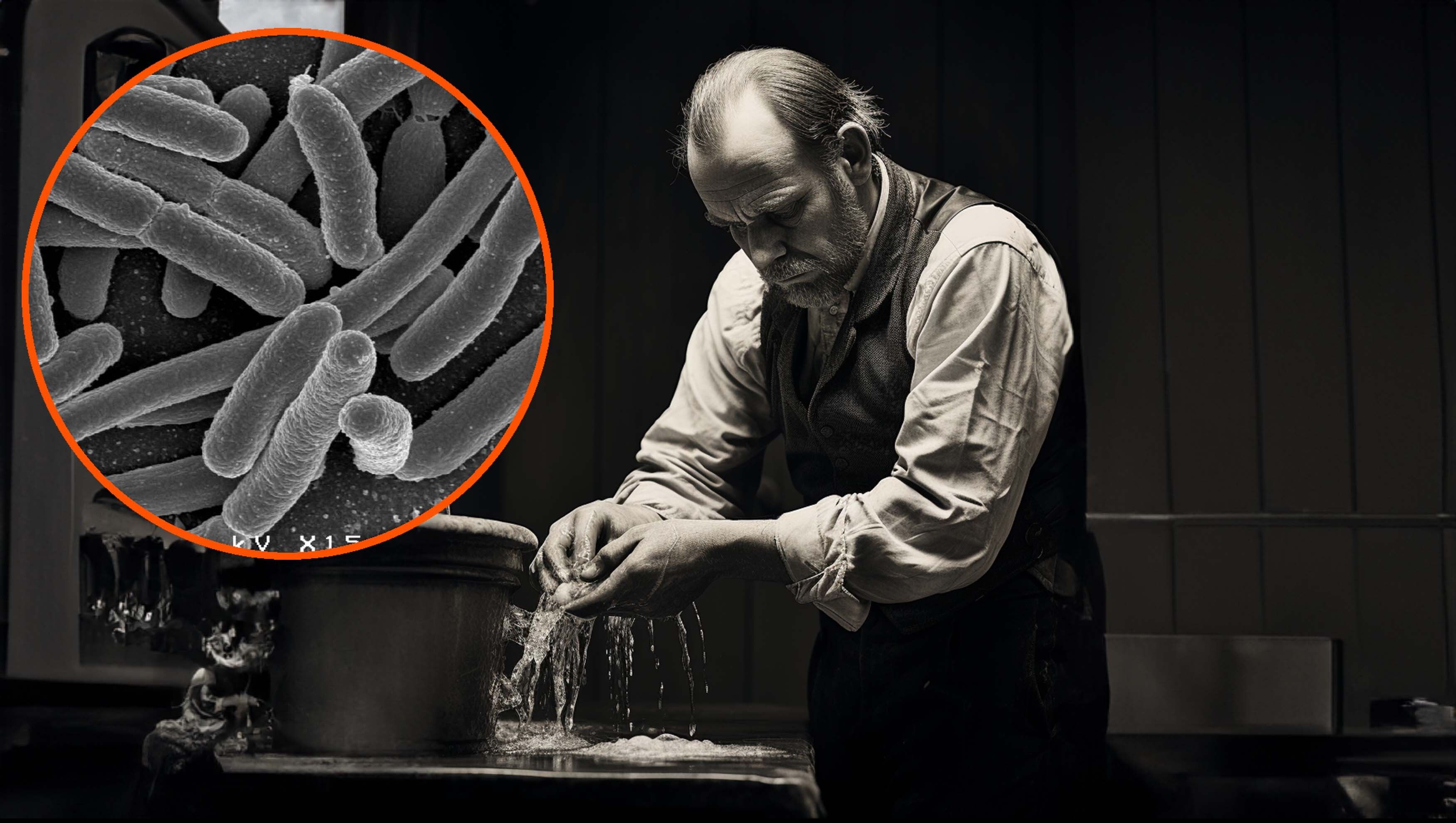The Guy Who Invented Hand Washing
Ignaz Semmelweis was a Hungarian Physician who hypothesized about the importance of washing hands for hygiene. It was a very particular case study in Vienna that led him to his conclusion, but no one took him seriously. It wasn’t until after his death that he was recognized as a medical revolutionary. In this episode, we talk about the story, including the case study that led Semmelweis to his beliefs, then we chat with Flexible Comedian Jonathan Burns!

As I was traveling back from Pennsylvania last week, I stopped at a gas station to get a snack and use the restroom. And the guy in the urinal next to me walked out of the bathroom without washing his hands. I might not have cared that much if he just left the gas station, but he stayed there to shop, picking up random items here and there. And so I skipped my plan to get snacks until the next stop.
By now, we all know to wash our hands. Every public restroom at a store or restaurant has a sign that their employees must wash their hands. Hospitals have entire rooms dedicated to scrubbing in before surgery.
It wasn’t always that way. Our story will talk about how it all began and the growing pains associated with new scientific discoveries. But first a few interesting facts about hygiene. These are statistics from the CDC.
- Out of the 7.8 billion people in the world, as many as 2.3 billion don’t practice proper hygiene like hand washing with soap and water – many of those are because of the lack of access to soap and clean water.
- Washing hands with soap and water can reduce deaths from diarrheal disease by up to 50%. If everyone washed their hands properly, as many as 1 million deaths a year could be prevented.
- When it comes to respiratory illnesses like the common cold, hand washing could reduce the chance of catching cold by 16-21%.
- A large percentage of foodbourne illnesses and food-related disease outbreaks are spread by unwashed hands.
Experts suggest that when you wash your hands, you should use hot water and soap and water and rub your soapy hands together for at least 20 seconds. An easy way to time that is by singing Happy Birthday to yourself while washing your hands.
The World Health Organization spoke out to advocate for vigorous hand washing during the COVID-19 pandemic as an effective way to help fight the spread of the virus. They made press releases and statements to promote October 15th as Global Handwashing Day.
Hand washing wasn’t always accepted as a way to prevent disease. And while physicians and doctors have been washing their hands as part of hygiene since the 1880s, The CDC didn’t even start publishing hand washing guidelines until the 1980s. It’s just one of many medical breakthroughs that were original rejected. When the first vaccine was invented by Edward Jenner, it was met with criticism and ridicule. The church called it unchristian. Many parents claimed that mandatory vaccines were an assault on their personal freedom. Today, something like 4 million childhood deaths are prevented every year because of vaccination. It’s a good thing we’ve come a long way and no longer see people fighting vaccines because of religion or personal freedom, right?
The idea of genetics and the fact that we can inherit traits from our parents was an idea that Gregor Mendel first put forth in the 1850s and nobody believed him. Nobody read his works and it wasn’t until 30 years later that his theories were accepted.
Hand washing has a similar story.
Ignaz Semmelweis was born in Hungary in 1818. He graduated from medical school and began working in Vienna General Hospital’s maternity clinic in 1846. After working there for a few years, it was clear to him that there was a huge problem. One of the wards had a horribly high maternal mortality rate. It was the ward that was staffed by both physicians and medical students. Between 13 and 18 percent of all mothers giving birth were dying. The deaths were chalked up to what was called “Childbed Fever” or “puerperal fever.” Both of these terms were describing an illness that no one understood. At the time, dying by childbirth was of course much more common than it is today, but even by 1800s standards, this was high. By comparison, there was another ward at the maternity clinic in Vienna that was only seeing around 2% mortality in mothers. That ward was staffed by midwives. Semmelweis, nor anyone else at the clinic could account for why there was such a huge discrepancy between these wards. He started digging into it to figure out what was so different. They looked at the environment, the climate, the proximity to outside visitors – everything. The only thing that seemed to be different was that one ward was staffed by midwives – the other by physicians and students. The problem was recalled in Semmelweis’s book titled, “The Etiology, Concept and Prophylaxis of Childbed Fever” where he writes “Everything was in question; everything seemed inexplicable; everything was doubtful…Only the large number of deaths was an unquestionable reality.”
Even people outside the hospital were taking note. When women were admitted to the hospital in Vienna for childbirth, they dropped to their knees and begged to be placed in the ward with the midwives. The rate of mothers dying from this mysterious “Childbed Fever” was higher in the physician and student ward than it was when women gave birth outside of hospitals on the street. So why was it becoming so common in this one ward?
Finally, an accident that happened in the hospital caught the attention of Semmelweis. One of the doctors had been poked by a scalpel. That scalpel had been used on an autopsy and that doctor died with the same mysterious symptoms as these mothers in the birthing ward. This is when Ignaz Semmelweis experienced his lightbulb moment. He realized that the biggest difference between the ward with the physicians and students and the ward with the midwives was the kind of exposure that the staffers themselves were facing. The physicians and students were conducting autopsies and were learning on medical cadavers. They were working on these dead bodies with their bare hands, and then immediately going to the maternity ward to deliver babies. They were essentially inoculating the mothers with bacteria from dead bodies. Meanwhile, the midwives working in the other ward weren’t conducting autopsies, or getting near cadavers.
Remember – this was the 1840s. No one realized that bodies contained bacteria. Louis Pasteur hadn’t yet become a celebrity with his germ theory about bacteria. Nobody realized that the doctors were spreading disease. Semmelweis didn’t use the term bacteria. He concluded that the doctors were carrying around “decaying animal-organic matter” on their hands. He started an experiment inside the maternity ward. All staff attending patients were to wash their hands in a special chlorinated lime solution before touching pregnant mothers. Within 1 month, the maternal mortality dropped to just 1-2%. It worked. Washing their hands made the death rate plummet to match that in the midwives’ ward.
Despite the clear evidence, Semmelweis’s colleagues didn’t believe that the hand-washing had anything to do with it. The theory at the time was that disease spread through the air, not through contact. Their belief was that it was toxic odors that spread illness. So if there wasn’t an overwhelming noxious smell, then it couldn’t be disease. People did wash their hands back then, but it was only to get rid of smells. Not to get rid of any sort of disease or bacteria. Another problem was that Semmelweis was in Austria, and couldn’t speak the language very well. He was a Hungarian and so, while he was able to communicate to his coworkers, he never provided his findings to larger academic crowds and medical conferences. It wasn’t until 14 years later – in 1861, that he wrote his book about the subject. So for all those years, he was seen as sort of a quack doctor. Which is crazy, because he had the evidence – anecdotal as it was – from the Vienna Hospital to back up his theory.
There was another problem with Semmelweis. He didn’t handle it well when he wasn’t taken seriously. The communication problems didn’t end with language differences. He went around publicly berating any doctor or official who didn’t take his hand washing theory seriously. He insulted them and blamed them for the deaths of anyone who died from Childbed Fever. Doctors of course didn’t take kindly to one of their own blaming them for the death of patients. Especially when those doctors were operating exactly as they had been taught their whole lives. He wasn’t taken seriously by them because his experiments in hand washing were never presented in a formal, scientific way. So he could never overcome the belief perseverance that was prevalent among the doctors. They simply didn’t see enough to change their minds. Semmelweis was an obscure doctor in Vienna suggesting that these men – these doctors with a high social standing – have unclean hands. It was almost offensive to suggest.
Frustrated, and in the middle of an Austria that was experiencing political turmoil, Ignaz Semmelweis left the Vienna Hospital without saying a word to anyone and returned to Hungary. He published his book, which didn’t sell well and soon he descended into a dark depression and mental breakdown. He continued lashing out at his colleagues in the medical industry, calling them irresponsible murderers. He began drinking heavily, staying away from his family, choosing the company of prostitutes instead.
In 1865, Ignaz Semmelweis was committed to an insane asylum and placed in a strait jacket – a common practice for the time. He was beaten and abused – also not uncommon treatments for mental patients of the time. Two weeks after being admitted, a cut on his hand became infected and gangrenous and Semmelweis died on August 13th 1865 at the age of 47.
During his lifetime, Semmelweis’s medical contributions were never appreciated or recognized. The maternity ward where he worked saw death rates increase again after he left. It wasn’t that long after his death that Louis Pasteur gained International recognition for presenting what he called his germ theory. That invisible bacteria lived among us and caused infection and disease. But even that theory was at first met with resistance and ridicule. Florence Nightingale, who is known best for her contributions to medicine through nursing – particularly nursing wounded soldiers – was a huge advocate for cleanliness and hand washing. She taught her nurses the importance of hygiene and sanitation. There’s also some evidence that Boston Physician Oliver Wendell Holmes was coming to the same conclusions about hand washing around the same time. And though he never saw it in life, Ignaz Semmelweis is now celebrated as an innovator in medicine. He’s seen as the father of hand washing, a pioneer of antiseptic policy. He’s had hospitals and museums named after him. And perhaps most importantly for the future, a theory of education named for him. It’s called the Semmelweis Reflex. It’s described as a situation in which there is a reflex-like rejection of new knowledge just because it contradicts the norms and beliefs of the time. The Internet Says it’s True.

Review this podcast at https://podcasts.apple.com/us/podcast/the-internet-says-it-s-true/id1530853589
Bonus episodes and content available at http://Patreon.com/MichaelKent
For special discounts and links to our sponsors, visit http://theinternetsaysitstrue.com/deals

